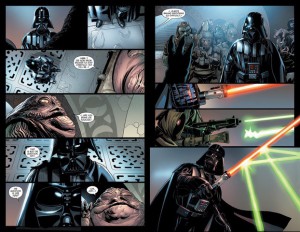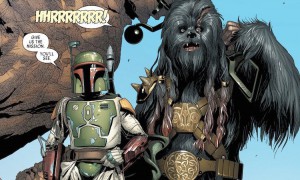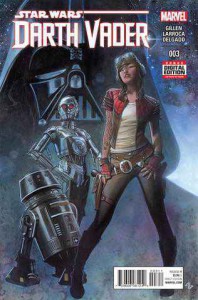As psychological subjects for a comic-book go, they don’t come much richer than the Dark Lord of the Sith, Darth Vader… or the Artist Formerly Known as Anakin Skywalker.
Though there are any number of characters from the rich Star Wars tapestry that I love, it’s hard to argue against Vader always having been the most fascinating.
Whether it was his mean, broody behaviour in The Empire Strikes Back, his faltering, troubled self-doubt in Return of the Jedi, or his tortured final days as a hero in Revenge of the Sith, Vader’s story is the mythological epic, the Greek tragedy, around which the Star Wars mythology rotates. While other characters might be the most lovable, the coolest, the funniest or the niftiest, Vader is undeniably the most psychologically complex.
He is therefore the perfect fictional legend to base a comic-book series around. And Darth Vader #1 exemplifies that.
The opening sequence of Jabba’s Palace made me happy (not an exaggeration: actually happy); it’s a brilliant play on Luke’s mission to Jabba’s Palace in ROTJ. Jabba’s Palace, with all its peculiarities and familiar details, and prompts an obvious nostalgic swell. The setting is, down to the last detail, so embedded into my mindscape from years of childhood (and beyond) fascination; and revisiting it feels strangely like coming home. Everything about this sequence – the way we see the giant door rise open and Vader silhouetted against the exterior light, entering the dark passageway, taking out the Gammorean guards, being approached by an objecting Bib Fortuna (how badly do we want to utter the words ‘De Wana Wanga’?), insisting on speaking to the Hutt and then finally entering into Jabba’s sleazy den, where the Hutt has to be woken up to deal with his visitor – it’s all measured to echo Luke and ROTJ perfectly.
To this end, it resonates really nicely.
There are differences though, serving to remind us of the difference between Luke and Vader and between Jedi and Sith; where Luke in ROTJ used the Force to subdue the Gammorean Guards and uses a Mind Trick to persuade Fortuna to admit him to Jabba, Vader uses his lightsaber to cut down the Guards and show his lightsaber to Fortuna to intimidate him into cooperation.
The pan image on page 9 of Vader facing Jabba while surrounded by Jabba’s diverse alien courtiers… is a direct throwback (or throw forward) to Luke/ROTJ again. The bounty hunter Dengar (one of my favorites) is discreetly visible. As are the slave-girl Oola, Salacious Crumb, members of the Max Rebo Band, and of course Boba Fett.
I also think I’m seeing the bounter hunters IG-88 and 4-Lom here… actually probably a bit crowded, come to think of it; as if someone wanted to shoe-horn in every Star Wars action-figure they’d had as a kid. And it was only the second time reading that I noticed Sy Snootles right in the back too. I can’t knock it though, as most comic-book (or Star Wars) fan-boys love noticing all those kinds of things.

A further homage to ROTJ comes on page 12 when Jabba tries to activate the same trap-door he will later use on Luke in ROTJ; unlike Luke, however, Vader is wholly wise to it and takes a step back to safety. Brilliant. Vader force-choking Jabba to show him who’s boss is a terrific moment too, again illustrating the difference between Vader and Luke and between Sith and Jedi.
But the most interesting thing in Darth Vader #1 is the dynamic between Emperor Palpatine and Darth Vader. The mistrust and even scheming between former Master and Apprentice is a far cry from the deferential relationship of Revenge of the Sith and much more in keeping with what we eventually see in Empire Strikes Back and Return of the Jedi.
Like true Sith Lords, they simply don’t trust each other anymore.
What’s also interesting is Palpatine’s generally dismissive, disrespectful treatment of the ‘Chosen One’ he once seduced to the Dark Side. The Anakin Skywalker who was once so important, the same former Jedi whose turn to the Dark Side was so instrumental in Palpatine’s plans to eliminate the Jedi Knights and overturn the Republic, is now just one more subordinate, one more underling, among many. We get the sense that Vader is even considered disposable. While on the one hand this simply reinforces Palpatine’s evil (as if it needed reinforcing), it also more interestingly reduces Vader to an almost pitiable figure at times.

This once great warrior, this once famed galactic hero, on whose actions the fate of the galaxy rested, is now little more than a glorified bureaucrat; a mere functionary in Palpatine’s vast empire. We can feel and understand Vader’s disillusion, even boredom, with the life he has now inherited.
And we can feel and understand the renewed sense of purpose, the flicker of excitement and possibility, he feels about the emergence of this mysterious, Force-sensitive X-Wing pilot who blew up the Death Star. With this mystery and this sense of connection, Vader finally has something new to be excited by; a ripple in the Force and an echo from that long-gone past in which life had been more exciting and rich.
The scenes on Coruscant with the Emperor also have that nostalgia factor for me, being that rare species that is a non-hater of the prequels.
Those scenes have a clear prequel feel or connection, while the silent presence of those classic Imperial Guards provides a sense of continuity and further homage. There are various other nice little touches and details. We see Vader using the same torture device he uses on Han Solo in ESB on one his officers, for example. Meanwhile the image of Vader and Palpatine walking the long corridor, with the sunlight shining across the array of grand pillars is a scene right out of Episode II featuring Obi-Wan, Mace Windu and Yoda, when the Emperor’s Palace used to be the old Jedi Temple.
I live for little details and connections like this, which really help the whole thing feel very well connected.
Later in #1, Vader is sent to Tatooine by the Emperor for a grim homecoming of sorts. There’s the real sense that Anakin isn’t at all happy to return to his home planet, with all its memories and associations with his childhood and all the long-lost emotional connections. The emergence of Boba Fett on page 30, though highly predictable (come on – as if the Fett wasn’t going to turn up), is nevertheless pleasing.
And who knew the Fettster had a Wookie sidekick just like Han? But the genius of this scene is the slow reveal showing that Vader has just slaughtered a bunch of Tusken Raiders. That really is genius touch, resonating as it does with Anakin’s slaughter of the Tuskens in Attack of the Clones.

“All my present busienss is concluded,” Vader says grimly, surrounded by dead Tuskens and their burning homes. The sense is that he simply couldn’t pass up the chance to finish the merciless job he started all those years ago as revenge of his mother, Shmi.
He clearly wasn’t on Tatooine for that reason; it was literally just something he decided to do as we was here anyway; it’s precisely that casual coldness that makes it so fascinating. What’s also fascinating about that is the unspoken implication that Vader is still, to whatever extent, emotionally connected with the events of Anakin Skywalker’s life and that those events still resonate with him and influence his decisions.
This little moment at the end really is a masterstroke.
Finally, to exert his authority over his apprentice even more, the Emperor puts Vader under the authority of Grand General Tagge (remember the Imperial Office Vader Force-chokes in A New Hope?), who patronises Vader and takes glee in his command over him. While Tagge may understandably be bitter over how Vader treated him on the Death Star, it does seem like ridiculously idiotic thing for him to deliberately disrespect and taunt the Dark Lord of the Sith – doesn’t he know what’ll happen? I mean Vader is clearly going to kill him at some point – I’d bet my life savings on that. But Tagge is surely well aware of how Vader treats Imperial Officers who even show incompetence, let alone deliberate disrespect? I guess we won’t have too much sympathy for him when he does eventually get choked out of existence.
All in all, Darth Vader #1 is a top-quality read; and by far the best single issue so far of these various Star Wars comics.
In #2, we have Vader on a mission for General Tagge; and as usual Vader is up to his own thing too, his own mission. It’s fun to see him playing these games; carrying out his own, secret initiatives while appearing to be conducting the Empire’s business on the surface.
What we also see, particularly in #2, is Vader as a lonely, isolated figure. He trusts no one, has no friends or loved ones, no connections, no real loyalties (not even to the Emperor).
It’s a barren, alienated life; the ultimate long-term consequence of Anakin Skywalker’s actions in the past.
Darth Vader #3 meanwhile introduces a fresh new fixture in the form of Doctor Aphra, an amoral ‘rogue archaeologist’ with a cool wit. She provides an interesting dynamic for the unexpressive Vader to play off of, which we don’t really see anywhere else. The sadistic droids ‘Triple Zero’ and ‘BT’ are also fascinating, if slightly off-beat, touch.
There’s something obviously unsettling about them, particularly as one of them is a Threepio-like protocol droid; but they’re an interesting addition to the mix. They are essentially an evil version of Artoo and Threepio.

Darth Vader #4 boasts a genuinely kick-arse cover, with Vader swinging his lightsaber in the midst of an array of Trade Federation Battle Droids. It’s a beautiful aesthetic convergence of Prequel and Original Trilogy and it looks great. Having said that, the simpler Delgado variant cover is also gorgeous, following a much more realist, textured depiction of Vader.
In #4, Vader returns to Geonosis presumably for the first time since the events of the Attack of the Clones film, accompanied this time by Aphra and her two ethically deficient droids.
There are very interesting details here. The fact that the the planet has been “sterilised” and the Geonosians have all been exterminated is curious. I wonder when that happened exactly and on whose orders; we assume it was an act of the Empire, but we’re not told. This little reference sort of highlights the point that, in my view anyway, there’s lot of material still left in and around the prequel era to be explored in future comics. The sight of the dead aliens laying exposed in the Geonosian desert is suitably grim, reminding us that the galaxy is a much bleaker place post-Revenge of the Sith than it once was.
When Aphra asks Vader, “have you ever been on Geonosis?”, Vader doesn’t answer. Instead we have a single panel image of the Anakin/Padme “I thought we had decided not to fall in love” scene from Attack of the Clones, and then a Vader who presumably doesn’t appreciate the memory simply says “cease your probing”.
There are a bunch of very good elements to Darth Vader #4. Coming upon the modified Trade Federation Battle Droids is a touch creepy, as they’ve been experimented on, fused with Geonosian traits. The Geonosian hive queen is also a slightly unsettling presence, but the scenario is compelling.
But the really great moment of this book is when Aphra, having finished her task for Vader, casually asks the Sith Lord if he’s going to kill her now. She fully expects it and is seemingly at peace with it (“If I get a choice, I’d like a lightsaber through the neck; no warning, nice and quick”). Vader spares her in an uncharacteristic act of mercy. Does he feel pity for her? Is he, on some level, fond of her? Or is it, just as he explains, that she is useful still?
You get the sense that he is quietly impressed with her at this moment; that she is so brave, so willing to face her fate, unlike the countless cowering Imperial Officers he has meanly killed over the years.

This is also the moment that Aphra becomes a genuinely good, interesting character and not just a temporary space filler.
This was something I didn’t expect from these Star Wars comics – to come across a brand new character, engaging in their own right. But Aphra has hit that mark and is a genuinely cool new fixture.
The arrival of Boba Fett’s Wookie sidekick, bringing a prisoner in the form of the Emperor’s lackey ‘Cylo V’ (last seen in Darth Vader #1) then reminds us immediately again that Vader is not someone you ever want to be on the wrong side of. The moment Vader hands him over to the sadistic protocol droid ‘Triple Zero’, we get possibly the most unsettling moment in all of these Star Wars comics; the droid is clearly, bleakly about to enjoy administering this torture session.
What I also love about this issue is how much it connects with the prequels, from the Geonosians and the classic Battle Droids (I miss those guys) to the brief Padme flashback, all of which help these comics to resonate across the entire breadth of the existing saga.
Darth Vader #5 sees Vader discover a group of diverse, lightsaber-wielding young warriors, who appear to be Jedi; but Vader immediately discerns they are something else entirely. I won’t put that particular spoiler in here, in case you haven’t read that far yet, but the answer is interesting. And when Palpatine reveals his presence, Vader finds himself facing a major challenge to prove his worth.
It’s intriguing stuff and moreover it’s a story that builds and builds, one subtle bit at a time. Of the three Star Wars titles I’ve been reading this year, Darth Vader has been the most interesting.
Fittingly, given the character, it is also the more ‘adult’ feeling, the more brooding, of the current titles. Kieron Gillen seems to have a really good grasp of Vader/Anakin, while Salvador Larocca and Edgar Delgado create a consistent, aesthetically involving quality of illustration and color that often seems to capture some unspoken, hard-to-define emotional undercurrent to Vader himself. It’s top-draw stuff on all those counts.
Darth Vader #6 is yet another really interesting issue. I’ll limit plot-details here, to avoid spoilers, but the Vader/Palpatine stuff is again particularly interesting, the tension and mistrust evident in their relationship. That mistrust was of course evident in Return of the Jedi, but only vaguely. What we’re getting here is an exploration when, why and how their relationship started to change.

The Vader flashback on page 17 to the Anakin/Padme “I’m pregnant” scene from Revenge of the Sith is terrific; it’s actually rendered perfectly too (I know that film like the back of my hand – these panels look remarkably like the actual scene). He also flashes back to the climatic scene of ROTS, where the Emperor informs him of Padme’s death; this is triggered by Boba Fett informing him of the name of the mysterious Jedi who blew up the Death Star (which he discovered in Star Wars #6 – I like the way these titles are occasionally feeding into each other).
We also get a flashback at the end to Padme’s Naboo funeral procession from ROTS, which is poignant (and also not entirely logical, as Vader/Anakin wasn’t at the funeral procession in ROTS and shouldn’t really be remembering it – but I won’t linger on that).
But the point of all this is to show how and when Vader’s relationship with the Emperor begins to evolve.
We imagine that were it not for this revelation about his son, Vader might never have begun to turn against Palpatine. He isn’t powerful enough to oppose the Emperor on his own. There’s a line here where Palpatine even calls him a disappointment, due to his mechanical nature, and even suggests that he regrets having rescued him from the fires of Mustafar back in ROTS – which is a horrible thing to say, and, we imagine, a painful and humiliating thing for Vader to hear, especially given everything else he also lost on Mustafar.
But now that he knows he has a son – and a Jedi son, no less – everything is different; and of course this is all setting us up perfectly for that climatic moment in the Empire Strikes Back where he tries to lure Luke into “ruling the galaxy as Father and Son”.
This is all great stuff, that’s working superbly on all those levels.
And this being the verdict of a lifelong Darth Vader/Anakin Skywalker obsessive. In short, if you’re a Vader or Star Wars fan and you haven’t yet read any of this Darth Vader series, do so at once.





It’s been many years since I purchased a graphic novel. These I may just have to go and get….
I highly recommend it, Helena. They’re very good. The Princess Leia series and the main Star Wars series you could probably take or leave, but the Vader series is well worth the effort.
Alan Dean Foster wrote a book called Splinter of the Mind’s Eye a good few years ago. Worth a read too, if you haven’t already (might be a bit YAish). I remember it as being more true to the canon than much that came afterward.
As for Vader, well, he’s been my favorite anti/villain/hero/slashy since forever. A redemption story is often such a powerful one….
Yeah, I read Splinter of the Mind’s Eye when I was a kid – wasn’t it like the *only* Star Wars novel around for ages? I don’t really remember it very well though.